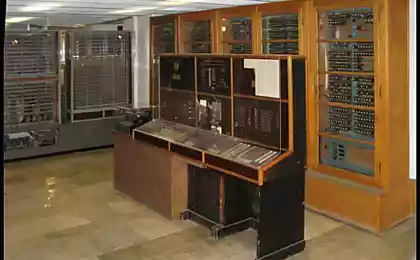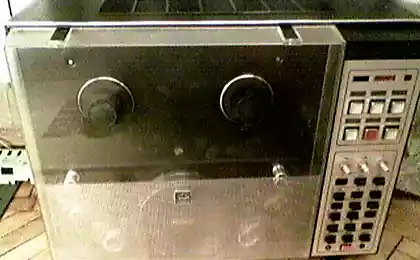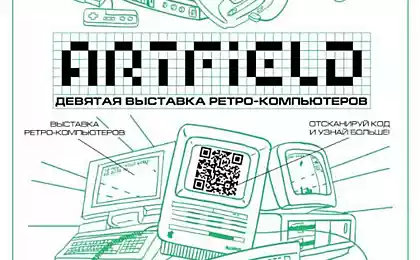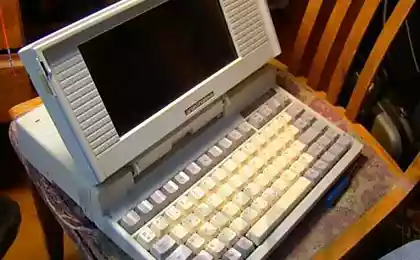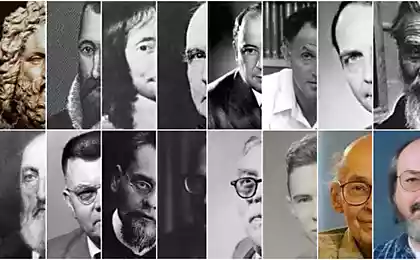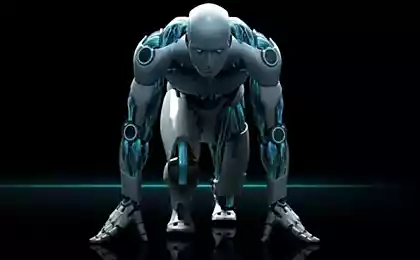2027
Konrad Zuse: a dreamer, who created the first computer
The Second World War gave a powerful impetus to the development of technology and science. Military-industrial complex is always going to huge human, financial and other resources. And the Nazis in their obsession to dominate the world, especially zealously worked on inventions and scientific and technical innovation. But no less than the history of creation of the first computer programming began even before the war, with the usual desire of a German architect to simplify your life. I>
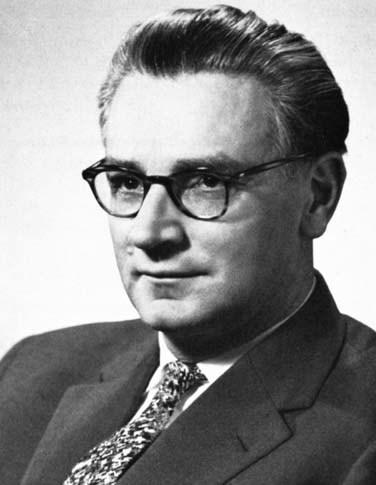
Konrad Zuse (1910-1995 yy.) i>
German engineer and inventor of the world's first working programmable computer Konrad Zuse got into the world of information technology almost by accident. The future inventor was endowed with some good talent for the fine arts, as well as loved building and construction. So he enrolled at the Berlin Technical University at the Faculty of Architecture and Civil Engineering (1930-1935), which became interested in mathematics and physics. During training, studying the construction of buildings and roads, Zuse was faced with a serious problem. This type of design solutions require huge systems of linear equations, which were very difficult to calculate using a slide rule or a mechanical calculator of the time.
As recalled Zuse: «I was a student in civil engineering in Berlin. Berlin - a beautiful city, which opens to the young man plenty of opportunities to spend time, for example, with a pretty girl. Instead, we were forced to carry huge and terrible calculations ». I>
For these failures, engineers used a special table, which recorded the formula to perform basic operations in the binary system. It was then that Zuse had the idea to automate this process by applying a simple computing device. In other words - to invent the first binary programmable computing machine.

(photo binary programmable computer Z1) i>
Through thorns to the stars
In 1936, Zuse completed logical plan for your first computer V1 (from the German Versuchsmodell-1, that is "experimental model"). In fact, the names of all the machines were to begin with V (V1 to V4), but after the Second World War, he changed the names on the Z1-Z4 (initial letter of the surname of the inventor) to avoid unpleasant associations with V1-V4 military rockets.
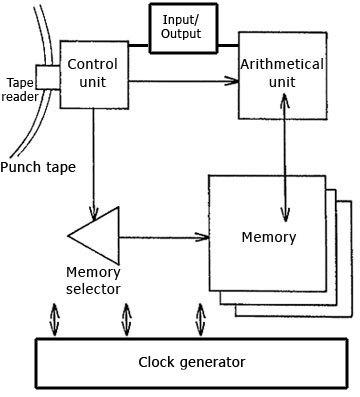
(draft plan) i>
Zuse had no experience in the field of electronics, do not have sufficient knowledge in the field of mechanics and, of course, could not know the principles of operation of other computing devices. But these circumstances it was not disturbed. The young inventor immediately began to implement its ideas. With the help of friends, he gathered a small amount of money for research, and together with a few friends went to work. The process of development and assembly took place in the Berlin apartment of his parents - home living room turned into a real workshop. No specially equipped laboratories, no help from the government, ministries or universities. Conrad did everything himself, creating a computer from virtually nothing. On the other hand, perhaps it is this fact gave him the advantage as he was able to look at the different issues of machine arithmetic and find a new approach to solving specific problems. Later, the inventor of writing that, owing to lack of information it was not limited to the search for a system to automatically calculate the best. After trying the decimal system, Zuse focused on binary.

(Zuse during operation) i>
Existed at the time the computational mechanisms were built using rotating components and operate on values in the decimal system. Z1 special feature was that it was engaged in the processing of numbers in the binary system, and are not used to switch the relay, and the metal plate. It should be noted that these plates were cut Zuse and his friends manually usual jigsaw (2000 pieces!). The plates are moved a certain direction. Offset plates indicating the calculated values and the values of mathematical operations, move a number of other plates, change the case of binary numbers and save intermediate results. These data make other changes. Actually asked the operator a simple sequential algorithm calculations and was the prototype of the modern computer program. A notable feature of the first computer has a keyboard for entering data with flashing lights to indicate the results.
Work on the invention took more than two years. In 1938, the Z1 machine saw the light. It was huge, consisting of 20 000 pieces. Electric motor power of 1 kW. provided one Hertz clock (one cycle per second).
Key Features Z1
Realization: thin metal plate
Rate: 1 Hz
Computing unit: processing floating-point
The average speed calculation: multiplication - 10 seconds, addition - 5 seconds
Data Entry: the keyboard, from a punched tape reader
Output: panel lamp (decimal representation)
Memory: 64 words of 22 bits
Weight: about 1000 kg
The first device Zuse had the ability to "save the program." Also, there was no conditional branch instruction. But whether or not wanting more of the machines built from metal plates and having 64 words of memory? Besides Zuse himself developed the theoretical basis for their computers. He was familiar with the binary digital system of Leibnitz. But I had no idea of George Boole algebra. He had to learn the mathematical logic of many prominent scientists to develop its own system, called the designation "Conditional combinatorial» (Bedingungskombinatorik).
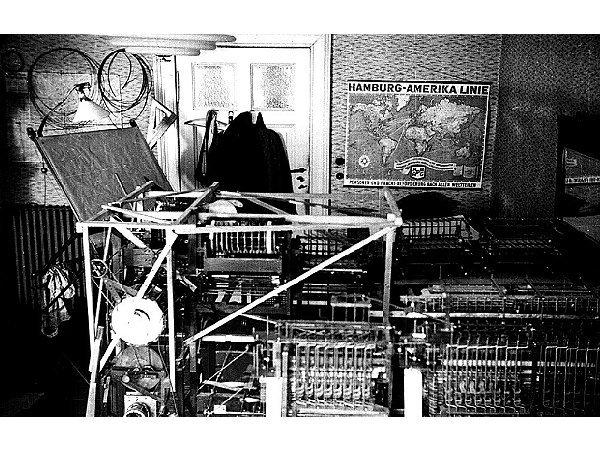
(living labor) i>
Mechanical Tsuza had great scientific value, showing the ability to create software of computers, working with binary code. But the reliability of the car was not very good. The device constantly broke because of poor quality equipment. In operation, the processor memory problem arises in the synchronization required to prevent excessive mechanical stress on the moving parts. But the architecture of the invention seemed quite successful and has led Zuse to consider other types of technology.
In further work on the machine greatly influenced each Zuse, an electronics engineer Helmut Schröer. He appreciated the development and suggested it improved by replacing the plate on vacuum tubes. And when you create a new model to save it logical principles of the previous one, allowing operators to perform mathematical operations with decimal numbers.
In 1938, Zuse and Schröer made a demonstration of the electronic circuits in the University of Berlin, telling in detail about the construction of an electronic computer. But as soon as they mention that such a device would require about 2,000 vacuum tubes and several thousand bulbs, as they nearly ridiculed. University scientists venture classified as fantasy the two dreamers. The fact that the largest electronic devices at the time consisted of only a few hundred electron tubes.
But criticism of professors did not influence the decision to carry out our plans, and friends assemble a new model.
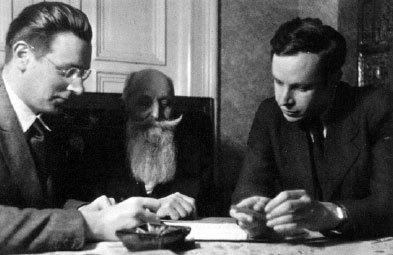
(fellow scientists Zuse and Schröer) i>
Trying to find funding Zuse tried to sign a contract with the former manufacturer of mechanical calculators Kurt Pannke. He received a polite refusal. Pannke expressed confidence that in the field of computers already invented everything possible. Nevertheless, the former manufacturer of calculators agreed to attend a workshop Zuse and was so impressed with his work that he decided to give the inventor seven thousand Reichsmarks.
The pursuit of excellence
Start of the Second World War put an end to joint research, Zuse was drafted into the Nazi army. He spent less than six months. Due to the request of influential scientists and engineers in 1940, Zuse was discharged in Berlin, where he became a member of Hitler's scientific elite.
Work on the relay electronic computer resumed. Schröer again offered his services. The researchers have applied for financial support to the military authorities, offering to develop a modern device for the air forces of Germany. Such a machine could quickly handle complex calculations, thus increasing the efficiency of tactical aviation. According to preliminary estimates of scientists for the invention of such a machine it would take about two years. But the military refused. Leaders of the Wehrmacht was convinced that for a period of Nazi Germany has already reached world domination.
Not losing hope, the scientists turned to the director of Berlin's aircraft factory «Henschel», effecting tactical bombers. And finally received approval, the factory seized the opportunity to use in the creation of military equipment and computer technology. Zuse was granted a special department with the best electronic engineer company. And in late 1940, Z2 was put into operation. The new computer was equipped with a digital signal processor-based relays and vacuum tubes. It automatically calculates the number of parameters of the geometry stabilizer bombs, converts them to analog value of the binary number system, calculating the required data on a pre-entered by the operator formulas and gave the finished result as a decimal. The results are sent directly to the production hall.
In the same year began the development of Zuse Z3 - Machine entirely built on the relay, but the logical structure of the Z1 and Z2. She was ready for operation in 1941, 4 years before the development of American Scientists - electronic digital computer ENIAC.

Programmable computer Z3 and was created on the basis of electronic relays (600 to arithmetic unit 1400 and memory control unit 400). In all other respects, it looked like the Z1 and Z2: binary number system, floating-point arithmetic unit with two 22-bit registers, control via 8-channel tape (ie, the team consists of 8 bits). Each of the words could be placed in the computer memory in a single clock cycle. Overall total memory up to 64 words of 22 bits. That this machine was first used by the modern principle of the address memory allocation when each 22-bit word can be placed in or removed from the memory of her teams and PRz PSz (z - corresponding register random access memory with addresses from 1 to 64). Computer Arithmetic unit accounted for parallel adders that were used to process the logarithmic expressions and floating point numbers.
Zuse developed a set of instructions, which included about a dozen major and dozens of other teams. It was a real programming language used to define complex algorithms computing. So Zuse is credited with creating the first and even high-level language - plankalkül (German Plankalkül - «calculus plans"). Its unique features are: free portability (independence from the architecture and instruction set of the machine), the operators of the conditions (except ELSE), loops, subroutines, no recursion, work with arrays and subarrays and complex syntax
In December 1941, the Z3 was put into operation and then been adopted by manufacturers of military aircraft. It is computed using the Z3 aerodynamic and ballistic characteristics of the first German cruise missiles.
After the successful implementation of the military industry Z3, Zuse contracted with Research-controlled German Air Force (DIV) for the design of electrical computing machine of the new generation.
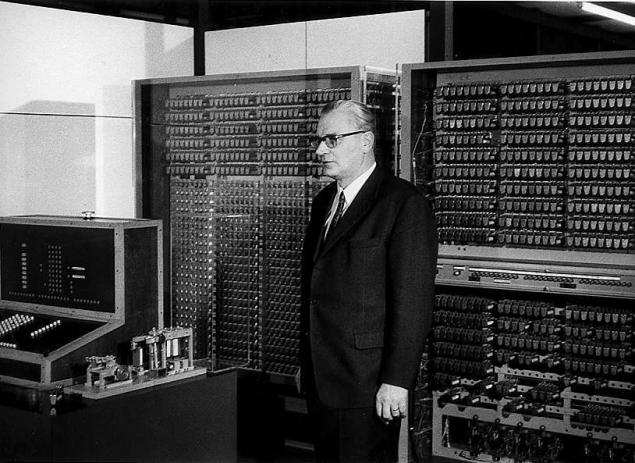
(in the background Zuse Z3) i>
The long-awaited Z4
The new model was very similar to the Z3, including in all the advanced development Zuse. This computer included elements: 2500 relay, step relay 21. He had already in 1024 registers a memory for storing 22-bit words. Thanks to more powerful processors has increased the speed of the conversion of binary numbers. Z4 has a device for preparation of the program. He also knew how to avoid incorrect calculation results. Power consumption of the machine was 4 kW.
Creating a new computer took three years to December 1944 and the project is nearing completion. Working on the Z4, the inventor put the main objective to build a prototype of a machine that later could produce thousands. But the absence of the necessary materials and the difficult situation in the country (the height of hostilities), made this task almost impossible. During one of the air raids on Berlin, the first copy of Z3 was completely destroyed, and when, in May 1945 in the German capital became the Soviet army, Zuse was forced to flee with his family in Bavaria. With him he certainly picked already assembled computer Z4. In the Bavarian Alps, he hid the car to a quiet time.
Key Features Z4
Realization: Relay, memory - metal plates
Rate: 30 Hz
Computing unit: processing floating-point numbers, the length of the machine word - 32 bits
The average speed calculation: 0, 4 seconds to build, 0, 3 seconds for multiplication
The average speed calculation: 11 multiplications per second
Data Entry: The decimal keyboard with a punched tape reader
Output: typewriter brand «Mercedes»
Memory: 64 words of 22 bits
Weight: about 1000 kg

(computer Z4) i>
In 1948, Zuse contacted Professor Edward Stiefel, who admitted Z4 suitable for scientific calculations. Although a little old-fashioned technology machines, Stiefel was impressed by the simplicity of programming and the power arithmetic unit with its ability to handle exceptions.
Encouraged by this success, Zuse set up his own company Zuse KG. In fact, it was the world's first commercial company exclusively dedicated to the development and production of computer technology for aviation and the optical industry, university laboratories. The company has established the commercial release of the computers that are popular in Germany 50s (Z5, Z11, Z22 and Z23). The company Zuse built the first computer with a memory on magnetic media Z22.
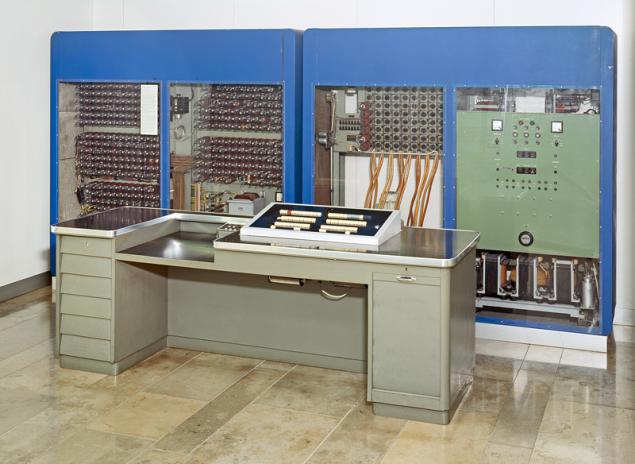
(computer memory on magnetic media Z22) i>
Despite the engineering talent and diligence, Zuse lagged behind their American competitors. Postwar Germany was not the most suitable place for innovation in the electronic future. All proceeds went to the government rebuild the country. Yes, and Zuse did not have the necessary infrastructure for further development. He could not in time to learn about new devices and programs.
And in the 60 years the European market actively filled American electronic computers, which gradually replaced the computers Zuse. In 1962 the company was sold to the company «Brown Boveri and Co», and later became a member of the corporation «Siemens».
Konrad Zuse described himself as an apolitical person. Affair of his life he believed the development of computer technology in Germany and regretted that he had not realized his dream - to create a portable PC for business people. This outstripped its US developers. After selling the company he started his long-time passion - painting. And even wrote a few portraits of famous people in the world of computer technology. One of them was Bill Gates, with whom the university met at the exhibition.
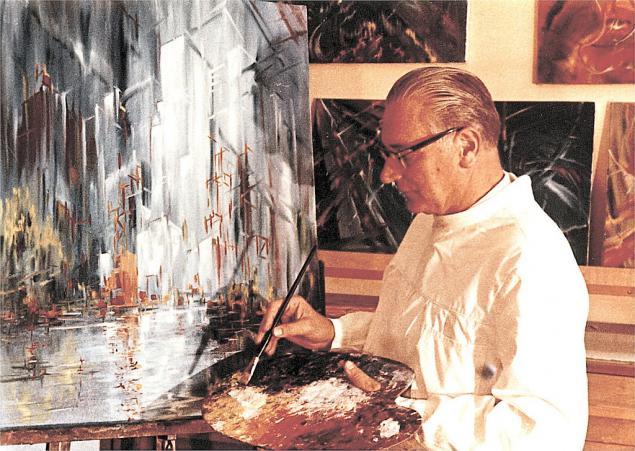
(Zuse for his second favorite pastime) i>
Konrad Zuse died in 1995 in the city Hyuhnfeld (Germany), before the age of eighty-five.
The original Z1, Z2, and Z3 have not survived to this day, they were destroyed during the bombing of Berlin in 1945. But Zuse managed to save a computer Z4, which is the home of the inventor in the Technical Museum in Berlin.
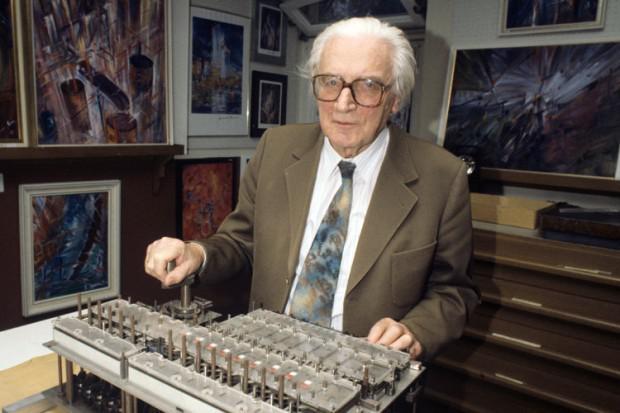
California Computer History Museum in Mountain View posthumously included in its membership Konrad Zuse, the inventor as an outstanding first fully automated computer controlled.
Source: geektimes.ru/company/ua-hosting/blog/265362/

Konrad Zuse (1910-1995 yy.) i>
German engineer and inventor of the world's first working programmable computer Konrad Zuse got into the world of information technology almost by accident. The future inventor was endowed with some good talent for the fine arts, as well as loved building and construction. So he enrolled at the Berlin Technical University at the Faculty of Architecture and Civil Engineering (1930-1935), which became interested in mathematics and physics. During training, studying the construction of buildings and roads, Zuse was faced with a serious problem. This type of design solutions require huge systems of linear equations, which were very difficult to calculate using a slide rule or a mechanical calculator of the time.
As recalled Zuse: «I was a student in civil engineering in Berlin. Berlin - a beautiful city, which opens to the young man plenty of opportunities to spend time, for example, with a pretty girl. Instead, we were forced to carry huge and terrible calculations ». I>
For these failures, engineers used a special table, which recorded the formula to perform basic operations in the binary system. It was then that Zuse had the idea to automate this process by applying a simple computing device. In other words - to invent the first binary programmable computing machine.

(photo binary programmable computer Z1) i>
Through thorns to the stars
In 1936, Zuse completed logical plan for your first computer V1 (from the German Versuchsmodell-1, that is "experimental model"). In fact, the names of all the machines were to begin with V (V1 to V4), but after the Second World War, he changed the names on the Z1-Z4 (initial letter of the surname of the inventor) to avoid unpleasant associations with V1-V4 military rockets.

(draft plan) i>
Zuse had no experience in the field of electronics, do not have sufficient knowledge in the field of mechanics and, of course, could not know the principles of operation of other computing devices. But these circumstances it was not disturbed. The young inventor immediately began to implement its ideas. With the help of friends, he gathered a small amount of money for research, and together with a few friends went to work. The process of development and assembly took place in the Berlin apartment of his parents - home living room turned into a real workshop. No specially equipped laboratories, no help from the government, ministries or universities. Conrad did everything himself, creating a computer from virtually nothing. On the other hand, perhaps it is this fact gave him the advantage as he was able to look at the different issues of machine arithmetic and find a new approach to solving specific problems. Later, the inventor of writing that, owing to lack of information it was not limited to the search for a system to automatically calculate the best. After trying the decimal system, Zuse focused on binary.

(Zuse during operation) i>
Existed at the time the computational mechanisms were built using rotating components and operate on values in the decimal system. Z1 special feature was that it was engaged in the processing of numbers in the binary system, and are not used to switch the relay, and the metal plate. It should be noted that these plates were cut Zuse and his friends manually usual jigsaw (2000 pieces!). The plates are moved a certain direction. Offset plates indicating the calculated values and the values of mathematical operations, move a number of other plates, change the case of binary numbers and save intermediate results. These data make other changes. Actually asked the operator a simple sequential algorithm calculations and was the prototype of the modern computer program. A notable feature of the first computer has a keyboard for entering data with flashing lights to indicate the results.
Work on the invention took more than two years. In 1938, the Z1 machine saw the light. It was huge, consisting of 20 000 pieces. Electric motor power of 1 kW. provided one Hertz clock (one cycle per second).
Key Features Z1
Realization: thin metal plate
Rate: 1 Hz
Computing unit: processing floating-point
The average speed calculation: multiplication - 10 seconds, addition - 5 seconds
Data Entry: the keyboard, from a punched tape reader
Output: panel lamp (decimal representation)
Memory: 64 words of 22 bits
Weight: about 1000 kg
The first device Zuse had the ability to "save the program." Also, there was no conditional branch instruction. But whether or not wanting more of the machines built from metal plates and having 64 words of memory? Besides Zuse himself developed the theoretical basis for their computers. He was familiar with the binary digital system of Leibnitz. But I had no idea of George Boole algebra. He had to learn the mathematical logic of many prominent scientists to develop its own system, called the designation "Conditional combinatorial» (Bedingungskombinatorik).

(living labor) i>
Mechanical Tsuza had great scientific value, showing the ability to create software of computers, working with binary code. But the reliability of the car was not very good. The device constantly broke because of poor quality equipment. In operation, the processor memory problem arises in the synchronization required to prevent excessive mechanical stress on the moving parts. But the architecture of the invention seemed quite successful and has led Zuse to consider other types of technology.
In further work on the machine greatly influenced each Zuse, an electronics engineer Helmut Schröer. He appreciated the development and suggested it improved by replacing the plate on vacuum tubes. And when you create a new model to save it logical principles of the previous one, allowing operators to perform mathematical operations with decimal numbers.
In 1938, Zuse and Schröer made a demonstration of the electronic circuits in the University of Berlin, telling in detail about the construction of an electronic computer. But as soon as they mention that such a device would require about 2,000 vacuum tubes and several thousand bulbs, as they nearly ridiculed. University scientists venture classified as fantasy the two dreamers. The fact that the largest electronic devices at the time consisted of only a few hundred electron tubes.
But criticism of professors did not influence the decision to carry out our plans, and friends assemble a new model.

(fellow scientists Zuse and Schröer) i>
Trying to find funding Zuse tried to sign a contract with the former manufacturer of mechanical calculators Kurt Pannke. He received a polite refusal. Pannke expressed confidence that in the field of computers already invented everything possible. Nevertheless, the former manufacturer of calculators agreed to attend a workshop Zuse and was so impressed with his work that he decided to give the inventor seven thousand Reichsmarks.
The pursuit of excellence
Start of the Second World War put an end to joint research, Zuse was drafted into the Nazi army. He spent less than six months. Due to the request of influential scientists and engineers in 1940, Zuse was discharged in Berlin, where he became a member of Hitler's scientific elite.
Work on the relay electronic computer resumed. Schröer again offered his services. The researchers have applied for financial support to the military authorities, offering to develop a modern device for the air forces of Germany. Such a machine could quickly handle complex calculations, thus increasing the efficiency of tactical aviation. According to preliminary estimates of scientists for the invention of such a machine it would take about two years. But the military refused. Leaders of the Wehrmacht was convinced that for a period of Nazi Germany has already reached world domination.
Not losing hope, the scientists turned to the director of Berlin's aircraft factory «Henschel», effecting tactical bombers. And finally received approval, the factory seized the opportunity to use in the creation of military equipment and computer technology. Zuse was granted a special department with the best electronic engineer company. And in late 1940, Z2 was put into operation. The new computer was equipped with a digital signal processor-based relays and vacuum tubes. It automatically calculates the number of parameters of the geometry stabilizer bombs, converts them to analog value of the binary number system, calculating the required data on a pre-entered by the operator formulas and gave the finished result as a decimal. The results are sent directly to the production hall.
In the same year began the development of Zuse Z3 - Machine entirely built on the relay, but the logical structure of the Z1 and Z2. She was ready for operation in 1941, 4 years before the development of American Scientists - electronic digital computer ENIAC.

Programmable computer Z3 and was created on the basis of electronic relays (600 to arithmetic unit 1400 and memory control unit 400). In all other respects, it looked like the Z1 and Z2: binary number system, floating-point arithmetic unit with two 22-bit registers, control via 8-channel tape (ie, the team consists of 8 bits). Each of the words could be placed in the computer memory in a single clock cycle. Overall total memory up to 64 words of 22 bits. That this machine was first used by the modern principle of the address memory allocation when each 22-bit word can be placed in or removed from the memory of her teams and PRz PSz (z - corresponding register random access memory with addresses from 1 to 64). Computer Arithmetic unit accounted for parallel adders that were used to process the logarithmic expressions and floating point numbers.
Zuse developed a set of instructions, which included about a dozen major and dozens of other teams. It was a real programming language used to define complex algorithms computing. So Zuse is credited with creating the first and even high-level language - plankalkül (German Plankalkül - «calculus plans"). Its unique features are: free portability (independence from the architecture and instruction set of the machine), the operators of the conditions (except ELSE), loops, subroutines, no recursion, work with arrays and subarrays and complex syntax
In December 1941, the Z3 was put into operation and then been adopted by manufacturers of military aircraft. It is computed using the Z3 aerodynamic and ballistic characteristics of the first German cruise missiles.
After the successful implementation of the military industry Z3, Zuse contracted with Research-controlled German Air Force (DIV) for the design of electrical computing machine of the new generation.

(in the background Zuse Z3) i>
The long-awaited Z4
The new model was very similar to the Z3, including in all the advanced development Zuse. This computer included elements: 2500 relay, step relay 21. He had already in 1024 registers a memory for storing 22-bit words. Thanks to more powerful processors has increased the speed of the conversion of binary numbers. Z4 has a device for preparation of the program. He also knew how to avoid incorrect calculation results. Power consumption of the machine was 4 kW.
Creating a new computer took three years to December 1944 and the project is nearing completion. Working on the Z4, the inventor put the main objective to build a prototype of a machine that later could produce thousands. But the absence of the necessary materials and the difficult situation in the country (the height of hostilities), made this task almost impossible. During one of the air raids on Berlin, the first copy of Z3 was completely destroyed, and when, in May 1945 in the German capital became the Soviet army, Zuse was forced to flee with his family in Bavaria. With him he certainly picked already assembled computer Z4. In the Bavarian Alps, he hid the car to a quiet time.
Key Features Z4
Realization: Relay, memory - metal plates
Rate: 30 Hz
Computing unit: processing floating-point numbers, the length of the machine word - 32 bits
The average speed calculation: 0, 4 seconds to build, 0, 3 seconds for multiplication
The average speed calculation: 11 multiplications per second
Data Entry: The decimal keyboard with a punched tape reader
Output: typewriter brand «Mercedes»
Memory: 64 words of 22 bits
Weight: about 1000 kg

(computer Z4) i>
In 1948, Zuse contacted Professor Edward Stiefel, who admitted Z4 suitable for scientific calculations. Although a little old-fashioned technology machines, Stiefel was impressed by the simplicity of programming and the power arithmetic unit with its ability to handle exceptions.
Encouraged by this success, Zuse set up his own company Zuse KG. In fact, it was the world's first commercial company exclusively dedicated to the development and production of computer technology for aviation and the optical industry, university laboratories. The company has established the commercial release of the computers that are popular in Germany 50s (Z5, Z11, Z22 and Z23). The company Zuse built the first computer with a memory on magnetic media Z22.

(computer memory on magnetic media Z22) i>
Despite the engineering talent and diligence, Zuse lagged behind their American competitors. Postwar Germany was not the most suitable place for innovation in the electronic future. All proceeds went to the government rebuild the country. Yes, and Zuse did not have the necessary infrastructure for further development. He could not in time to learn about new devices and programs.
And in the 60 years the European market actively filled American electronic computers, which gradually replaced the computers Zuse. In 1962 the company was sold to the company «Brown Boveri and Co», and later became a member of the corporation «Siemens».
Konrad Zuse described himself as an apolitical person. Affair of his life he believed the development of computer technology in Germany and regretted that he had not realized his dream - to create a portable PC for business people. This outstripped its US developers. After selling the company he started his long-time passion - painting. And even wrote a few portraits of famous people in the world of computer technology. One of them was Bill Gates, with whom the university met at the exhibition.

(Zuse for his second favorite pastime) i>
Konrad Zuse died in 1995 in the city Hyuhnfeld (Germany), before the age of eighty-five.
The original Z1, Z2, and Z3 have not survived to this day, they were destroyed during the bombing of Berlin in 1945. But Zuse managed to save a computer Z4, which is the home of the inventor in the Technical Museum in Berlin.

California Computer History Museum in Mountain View posthumously included in its membership Konrad Zuse, the inventor as an outstanding first fully automated computer controlled.
Source: geektimes.ru/company/ua-hosting/blog/265362/
NASA scientists have identified the root cause of changes in the Martian atmosphere
Life is within reach: the search in the solar system


